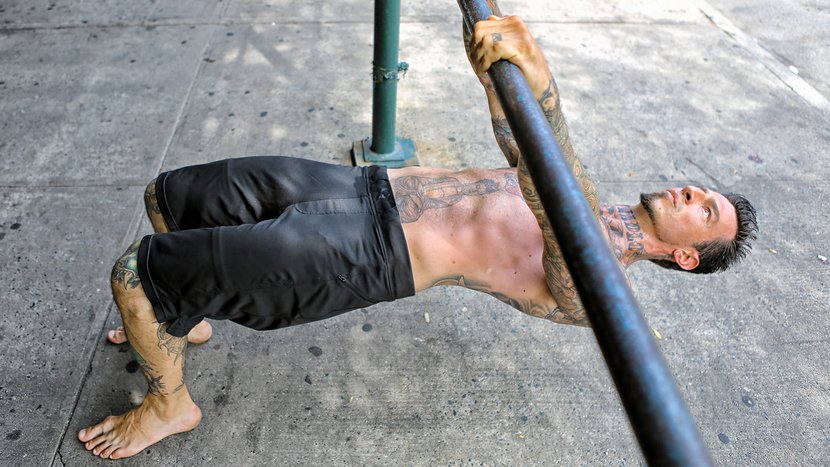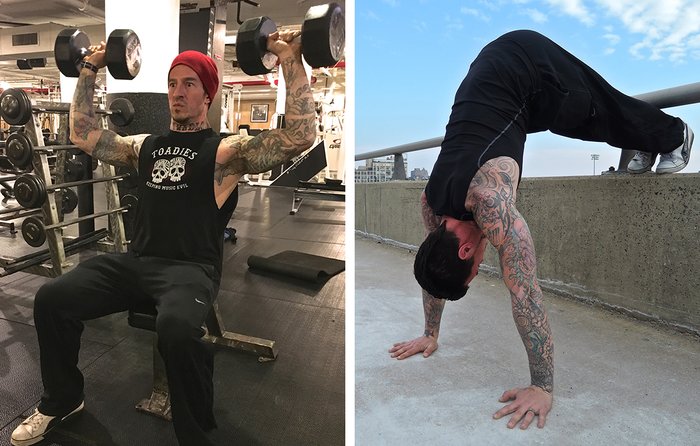
People are always asking me, "Danny, what should I do?" I get this question from practitioners of all training disciplines, not just calisthenics fanatics. If you're a trainer, you're probably nodding your head right now, because the subject of which specific exercises to do is almost unavoidable. Folks are continuously searching for the "best" exercise to target a particular body part, aesthetic effect, or muscle group. Seems reasonable, right?
I'm here to tell you that if you're even thinking in terms of exercises, you could be selling yourself short from the start.
In my last article, "Increasing Your Strength Without Using More Weight," I noted that I like to think in terms of movement patterns rather than exercises. Put another way, when you step back from a particular exercise and just focus on what your body is doing spatially, a push-up becomes a "horizontal push" and a pull-up becomes a "vertical pull." This simple change of thinking allows you to increase the resistance and effectiveness of any movement by making changes to the leverage, weight-to-limb ratio, or range of motion, while keeping the pattern the same.
Since then, my inbox has been blowing up.
So let's dig deeper into the patterns. Different coaches categorize them different ways, but for me, it all comes down to what I call the "Magnificent Seven." No matter your goals, these all need to be present and accounted for!
1. Overhead Press
This includes bodyweight moves like handstands or handstand push-ups, but also the military press, Arnold press, and plenty more. Any exercise that requires the practitioner to press away from his or her body in a vertical plane falls under this heading.

The primary movers here are your shoulders, traps, and triceps, although there are certainly differences from exercise to exercise. For example, a wall pike press-up requires more core stability than a seated dumbbell press, but the overall movement patterns are the same, and the yields are extraordinary from both.
2. Overhead Pull
Pull-ups, chin-ups, and lat pull-downs, including all their numerous grips, angles, and hand placements, are the big hitters in this category. They place the focus more on the lats and biceps, the antagonists to your pressing muscles.
Pulling in general is a fundamental component of full-body strength, which is sadly underrepresented in many styles of training. The calisthenics fanatic knows how important it is, though! You've simply got to train your back to be balanced, symmetrical, and truly strong, even if you can't see it in the mirror.
Whichever modality you choose to train, be sure you've got a balance of pushes and pulls in your regimen.
3. Horizontal Push
This is any exercise in which you push your arms out in front of your chest and away from your body. Push-ups and bench presses are clearly the gold standards here, but make no mistake, they come in far more variations beyond just wide-grip, narrow-grip, incline, and decline.
Furthermore, the choice between barbells, dumbbells and bodyweight training each have their own intrinsic distinctions. Barbells, of course, allow for maximal absolute strength. Dumbbells provide a greater grip workout, whereas unilateral and bodyweight variations train full-body coordination and muscular control.
Yes, you're hitting primarily the chest and triceps here, but if you've ever done the work to achieve your first single-arm push-up, you know that the shoulders, abs, lats, and glutes also come into play to provide stability and assistance. There is no true muscle isolation, as the body always has to work together in one cohesive unit.
4. Horizontal Pull
I love pull-ups as much as anybody, but I know I need my rows, too. Why? Typically, these exercises recruit more medial back muscles than the overhead pulls do, such as the rhomboids and spine erectors. If these crucial postural muscles are weak, something else is having to compensate—and that could be setting you up for trouble down the road.
So where do I get them? Australian pull-ups and suspension-strap pulls are great ways to get some volume.Dumbbell rows and bent-over rows are also classic moves here, along with the standard seated cable row.
If you want an elite row variation to aim for, try the front-lever pull-up. If you can knock out one of those cleanly, your back will show it from every angle.
5. Squat
The squat is the most foundational lower-body exercise there is, as well one of the most important movement patterns in general. You were a master of it as a kid, even though the hip, knee, and ankle range of motion you had then may have since slipped away. But it's not too late to get it back!
Squats are unique in that both the anterior (front) and posterior (back) of the legs are employed, including the quadriceps, hamstrings, glutes, and tibialis. Very much a full-body movement pattern, squats also recruit your hip flexors, spine erectors, abdominals, and more.
There are benefits to be gained from both bilateral and single-leg squat training, so save time for both. The foundation always has been—and still is—the simple bodyweight squat, but other worthy additions include thesplit-squat, walking lunges, and pistol squats, as well as the classic barbell lifts like back squats and front squats. Even the leg press is a variant of the basic squatting motion! Do not ignore this vital movement.
6. Forward Flexion
Examples of this motion include all variations of sit-ups, hanging leg raises, twisting knee raises, jackknife crunches, and a vast multitude of abs and core exercises. Weighted crunch machines fall into this category, too.
Basically, any exercise where the body bends forward, emphasizing the abdominals, is part of this group. Bear in mind that although the primary movers here are the abs, many of these exercises—particularly those exercises which require you to hang from a bar—recruit additional muscles like your lats, arms, and shoulders.
7. Hinge
This group is made up of extension-based movements that balance out the immense amount of forward flexion we tend to include in our workouts and our lives. Because of the emphasis many of us place on the "beach muscles" (abs and chest, for example), the muscles you can't see in the mirror often go undertrained. The importance of working the backside of your body cannot be understated.
You won't be functionally strong, sound, or physically unyielding if you're lacking in the posterior chain. There are many spectacular hinge movements, including but not limited to all forms of back bridging, the deadlift and its many incarnations, and the kettlebell swing.
Make no mistake: Although the primary movers in these exercises are the glutes, legs, upper back, and lower back, you must recruit your entire body in order to execute the hinge movement effectively. And your entire body will thank you for it.
Are You Training The Magnificent Seven?
Different people progress in different ways. A group of men and women could follow the same solid full-body training plan that hits all seven of these patterns, and each person would probably see one movement—horizontal push, for example—get stronger faster than another.
That's perfectly normal. They key is to not let your weaknesses become your blind spots. Get stronger at what you're lacking, stay strong at what you're crushing, and incorporate some flexibility work to enhance your overall training.
And yes, of course I get that these groupings are a generalization. There are many activities—calf raises, wrist curls, neck harnesses, you name it—that don't fit cleanly on this list. However, those are the dessert. These are the main course. Train the Magnificent Seven with consistency and intensity, and you will be in the best shape of your life!
Original article and pictures take www.bodybuilding.com site
Комментариев нет:
Отправить комментарий